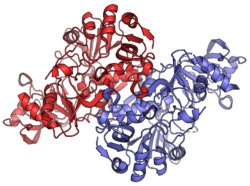Biology:3-oxoacid CoA-transferase
| 3-oxoacid CoA-transferase (SCOT) | |||||||||
|---|---|---|---|---|---|---|---|---|---|
 | |||||||||
| Identifiers | |||||||||
| EC number | 2.8.3.5 | ||||||||
| CAS number | 9027-43-4 | ||||||||
| Databases | |||||||||
| IntEnz | IntEnz view | ||||||||
| BRENDA | BRENDA entry | ||||||||
| ExPASy | NiceZyme view | ||||||||
| KEGG | KEGG entry | ||||||||
| MetaCyc | metabolic pathway | ||||||||
| PRIAM | profile | ||||||||
| PDB structures | RCSB PDB PDBe PDBsum | ||||||||
| Gene Ontology | AmiGO / QuickGO | ||||||||
| |||||||||
In enzymology, a 3-oxoacid CoA-transferase (EC 2.8.3.5) is an enzyme that catalyzes the chemical reaction
- succinyl-CoA + a 3-oxo acid [math]\displaystyle{ \rightleftharpoons }[/math] succinate + a 3-oxoacyl-CoA
Thus, the two substrates of this enzyme are succinyl-CoA and 3-oxo acid, whereas its two products are succinate and 3-oxoacyl-CoA.
This enzyme belongs to the family of transferases, specifically the CoA-transferases. The systematic name of this enzyme class is succinyl-CoA:3-oxo-acid CoA-transferase. Other names in common use include succinyl-CoA-3-ketoacid-CoA transferase, 3-oxoacid coenzyme A-transferase, 3-ketoacid CoA-transferase, 3-ketoacid coenzyme A transferase, 3-oxo-CoA transferase, 3-oxoacid CoA dehydrogenase, acetoacetate succinyl-CoA transferase, acetoacetyl coenzyme A-succinic thiophorase, succinyl coenzyme A-acetoacetyl coenzyme A-transferase, and succinyl-CoA transferase. This enzyme participates in 3 metabolic pathways: synthesis and degradation of ketone bodies,[1] valine, leucine and isoleucine degradation, and butanoate metabolism.
This protein may use the morpheein model of allosteric regulation.[2]
Structural studies
As of late 2007, 7 structures have been solved for this class of enzymes, with PDB accession codes 1M3E, 1O9L, 1OOY, 1OOZ, 1OPE, 2NRB, and 2NRC.
References
- ↑ Blanco, Antonio; Blanco, Gustavo (2017), "Chapter 15 - Lipid Metabolism" (in en), Medical Biochemistry (Academic Press): pp. 325–365, doi:10.1016/b978-0-12-803550-4.00015-x, ISBN 978-0-12-803550-4, https://www.sciencedirect.com/science/article/pii/B978012803550400015X, retrieved 2023-06-08
- ↑ T. Selwood; E. K. Jaffe (2011). "Dynamic dissociating homo-oligomers and the control of protein function.". Arch. Biochem. Biophys. 519 (2): 131–43. doi:10.1016/j.abb.2011.11.020. PMID 22182754.
- "Coenzyme A transferase. Kinetics and exchange reactions". J. Biol. Chem. 242: 3468–3480. 1967. doi:10.1016/S0021-9258(18)95886-2.
- "Enzymes of fatty acid metabolism". Biochim. Biophys. Acta 12 (1–2): 299–314. 1953. doi:10.1016/0006-3002(53)90149-8. PMID 13115439.
- "Enzymic synthesis and metabolism of malonyl coenzyme A and glutaryl coenzyme A". J. Biol. Chem. 235 (12): 3393–3398. 1960. doi:10.1016/S0021-9258(18)64478-3. PMID 13769479.
- "Enzymes of fatty acid metabolism. IV. Preparation and properties of coenzyme A transferase". J. Biol. Chem. 221 (1): 15–31. 1956. doi:10.1016/S0021-9258(18)65225-1. PMID 13345795.
 |

